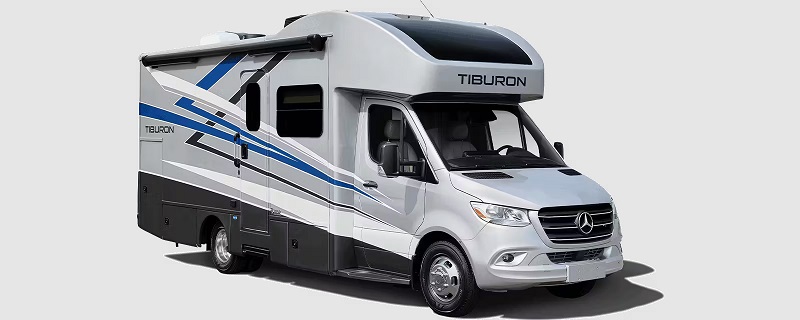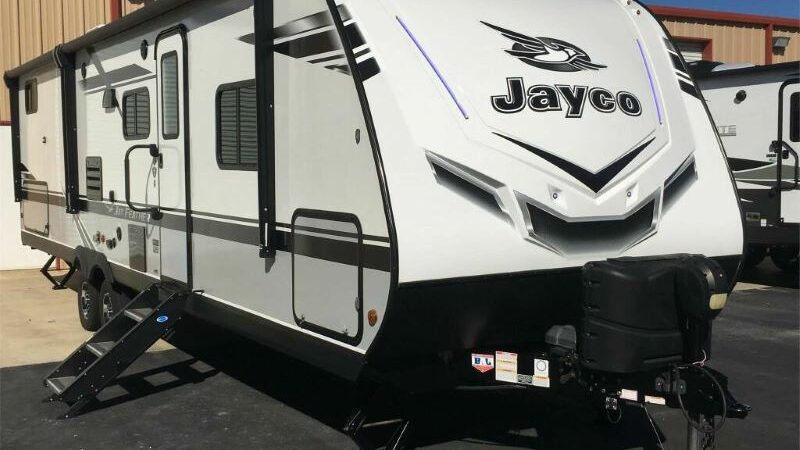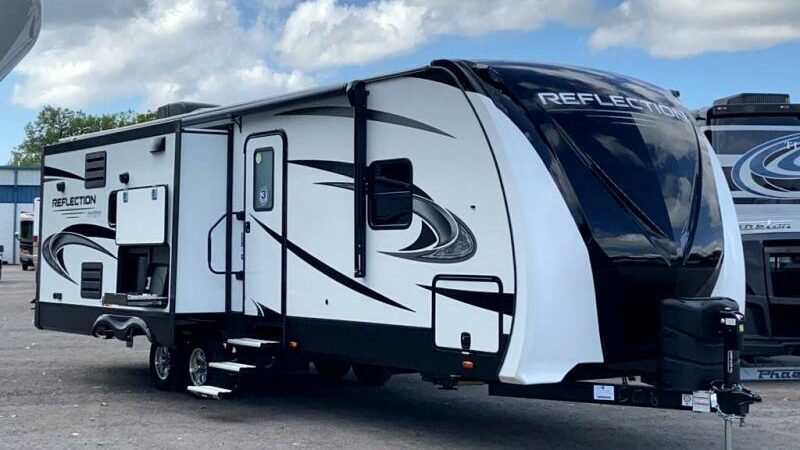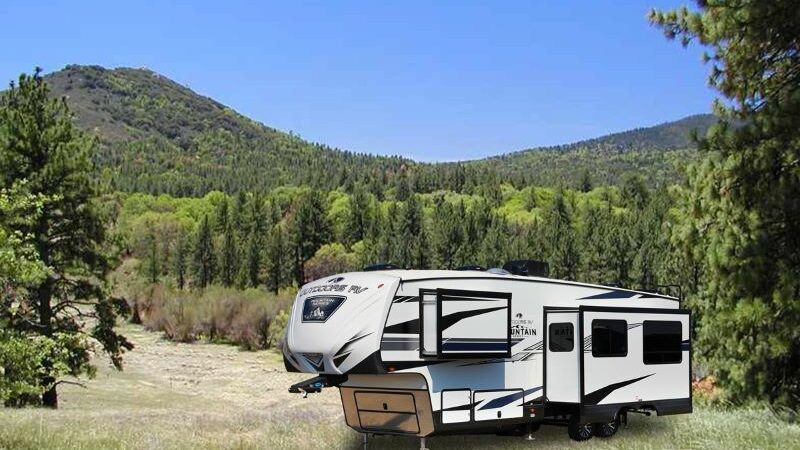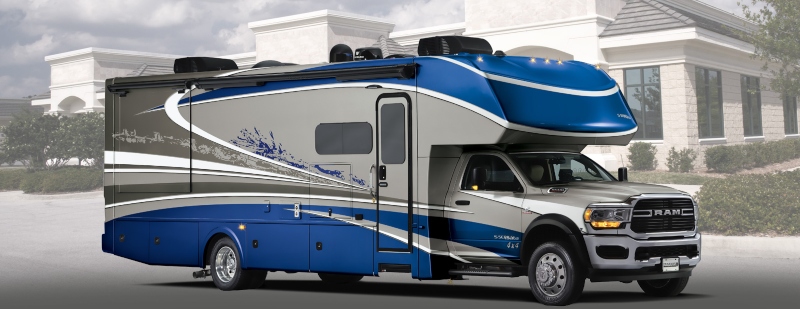How To Measure A Truck Camper’s Center of Gravity
Thanks for your support! If you make a purchase using our links in this article, we may make a commission. And, as an Amazon Associate, I earn from qualifying purchases. See the full disclosure here.
If you’re going all in for a truck camper, as a first-time RVer, one of the most notable specs is the truck camper’s center of gravity. You’ll see it on every new or used truck camper online, just like GVWR and towing specs on other types of RVs.
While it sounds like something out of a sci-fi novel, it’s really not that complicated. It’s not a term that’s prevalent among other RVs because It’s intrinsic to truck campers only.
Put simply, it’s where most of the weight resides, the primary point of the entire truck camper’s fulcrum. It’s necessary information to have for a number of reasons.
The truck camper’s center of gravity determines what kind of truck will handle it, how you go about packing your camper, and how you will ultimately drive the truck.
It’s like being on a skateboard, a bicycle, or a standup paddleboard. Before you achieve maximum efficiency on any of those recreational items, you have to determine and get a feel for your center of gravity.
What Is A Truck Camper’s Center Of Gravity?
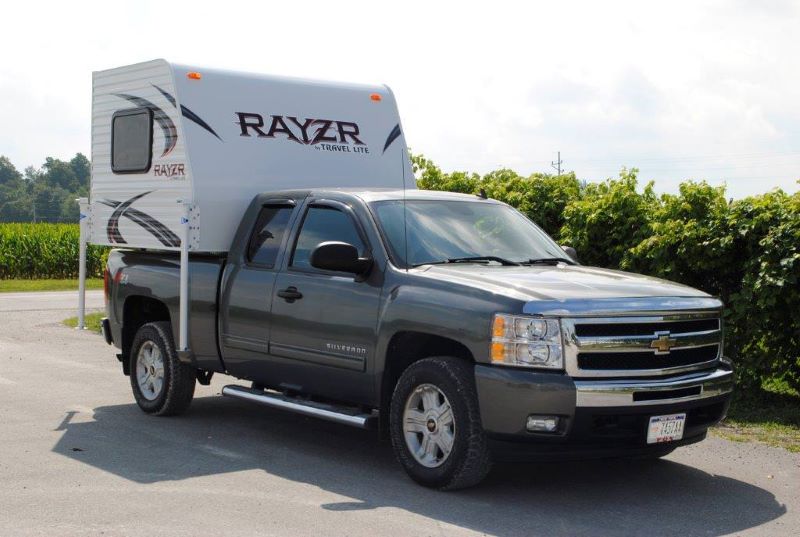
The truck camper’s center of gravity is the exact point inside the truck camper where the vast majority of the weight is centralized.
It’s the point you stand on when you’re on a surfboard or even a motorcycle. The dynamics of the vehicle may change, but the center of gravity is an exact point on all of them.
This makes sense when you realize that the point where the most weight rests is also the balance point of the truck camper. It doesn’t have to be directly in the center of the truck camper, either. In fact, most of the time, it isn’t.
If you measure and determine the exact center point of the camper, odds are good it’s not the camper’s center of gravity.
If you want to find the truck camper’s center of gravity, there’s a way to do that, which we’ll cover more in-depth below.
The point is that people have a tendency to associate a center point with the center of gravity, and that doesn’t work in this case.
Why Is Truck Camper Center of Gravity Important?
Not knowing the center of gravity puts your truck at extreme risk, to the point of becoming undrivable. Knowing the GVWR (Gross Vehicle Weight Ratio), CCC (Cargo Carrying Capacity), and dry weight is all well and good. However, the center of gravity (CoG) is where it’s at.
Most of the weight on a truck camper (that matches your truck) will rest on or just in front of the rear axle. Axles are everything when it comes to weight, and even some Class A motorhomes will throw in an extra tag axle just to handle all that excess weight.
If the brunt of the weight isn’t located over the axle, bad things tend to happen. Everything under the front hood of your truck serves as a sort of counterbalance to the weight of the truck camper.
Shift that truck camper weight too far back, and you take too much weight off the front axle. The ideal scenario is a seesaw effect where each person sitting on either end of the seesaw is perfectly balanced, forcing the seesaw to come to rest horizontally.
If the weight is too far back, it also changes the pivot point, something we talked about in our turning radius article on RVBlogger.com. Lifting weight off the front axle changes the dynamics of driving and puts you, along with any passengers and people sharing the road with you at risk.
How Do You Measure Truck Camper Center of Gravity?
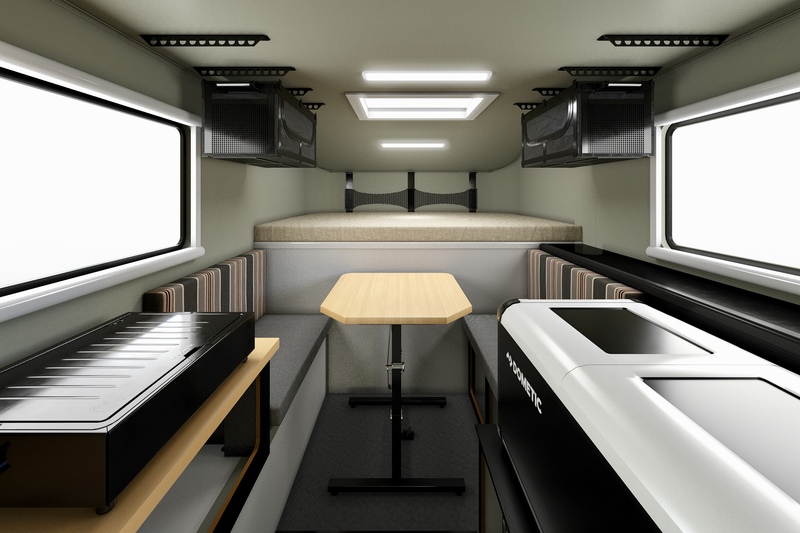
Measuring the truck camper’s center of gravity doesn’t end there. You also need to measure the center of gravity on your truck bed. This is where you want the CoG of the camper to rest, one CoG stacked on top of another.
Fortunately, truck camper manufacturers provide potential customers with key information about the CoG in the specs.
These specs are likely located in the camper (maybe in the form of a sticker on the window or on the website the truck camper is advertised on.
Some campers will have a directional arrow, pasted on the truck camper, pointing at the CoG. However, an arrow is not an exact science, so you’ll still need a measurement.
First, let’s start with the truck camper’s center of gravity. The truck camper’s CoG is an inch measurement. When you look at the specs, you will see the term, “center of gravity”, along with the associated inches. The manufacturer is telling you how many inches the CoG is from the front wall.
All you require is a visual marking. If the CoG is 45″, measure from the front wall of the camper, 45″ toward the back wall. When you reach 45″, that’s your CoG. When we say “front wall”, we mean the front of the camper box, not the overhang.
How Do You Know Your Truck Bed Center Of Gravity?
This is the point where you measure the CoG in your truck bed, which is just as simple as measuring the CoG in the truck camper. This measurement runs from the front of your truck’s bed to the top, center of your rear axle.
Feel free to mark it in whatever way you feel is best because that’s your truck bed’s center of gravity. This point, in your truck bed, is where the CoG of the truck camper should rest. It can be slightly forward of it, but never behind it (toward the tailgate).
The CoG in your truck bed will generally be the center of the tire, but measuring it out will provide you with a more specific spot to go with.
How Are Truck Campers Held In Place?
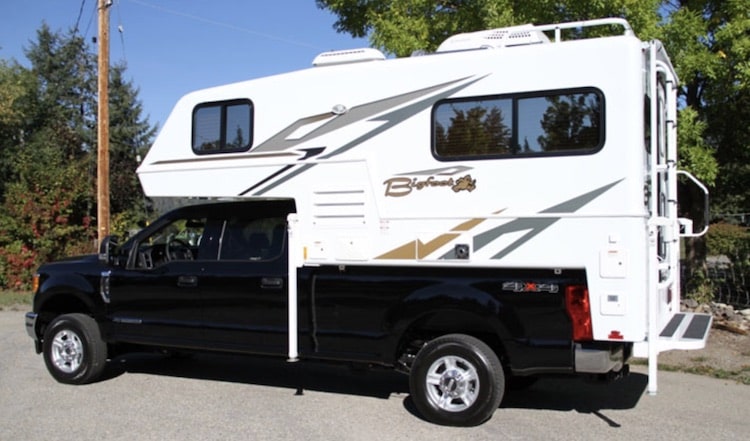
One thing is for sure: you won’t be using zip ties. At least we strongly advise you not to use zip ties. Duct tape either.
Before installing a truck camper in the bed, get the GVWR, curb weight, payload capacity (GVWR – curb weight), truck camper center of gravity, and truck bed center of gravity.
Determining the payload capacity is important because it’s the maximum amount of weight your truck will safely haul. If your truck has a GVWR of 10,000 lbs and a curb weight of 6,000 lbs, your payload capacity is 4,000 lbs.
Truck campers are mounted and held in place with a variety of methods, including frame mounting, bed-rail mounting, and bumper mounting.
Regardless of the mounting mechanism, tie-downs and turnbuckles are a part of it. In general, there are four tie-downs, whether it’s a bumper, frame, or bed-rail system.
Bed-Rail Mounting
As the name implies, the truck camper bolts to the bed of your truck, usually by means of drilling holes through the bed. This might not be everyone’s cup of tea because you might not always have the truck camper.
Once the holes are installed, the anchor plates come next. Anchor plates are either standard size or wider for larger truck beds and a more expansive attachment point.
Bumper Mounting
Bumper mounting systems are for lighter truck campers. No matter what kind of wild and interesting new bumper Ford, Chevy, Ram, Nissan, or Toyota comes out with, the bumper will never be as strong as the frame of the truck. Much heavier truck campers should never mount with bumper mounts.
Frame Mounting
This is probably the strongest mounting mechanism for a truck camper, with the bed rail being a close second. The installation includes a lower and upper connection point on each of the four corners of the truck bed frame. These are the mounts you want for a massive truck camper.
Turnbuckles
Turnbuckles are more of a reinforcement mechanism. Mostly, they’re for increasing the rigidity of a mounting point. Of course, you can also use them to decrease the tension as well.
Turnbuckles come in a variety of forms as well, including chains, quick-release, lever, spring, and traditional.
How Big Of A Truck Do You Need For A Truck Camper?
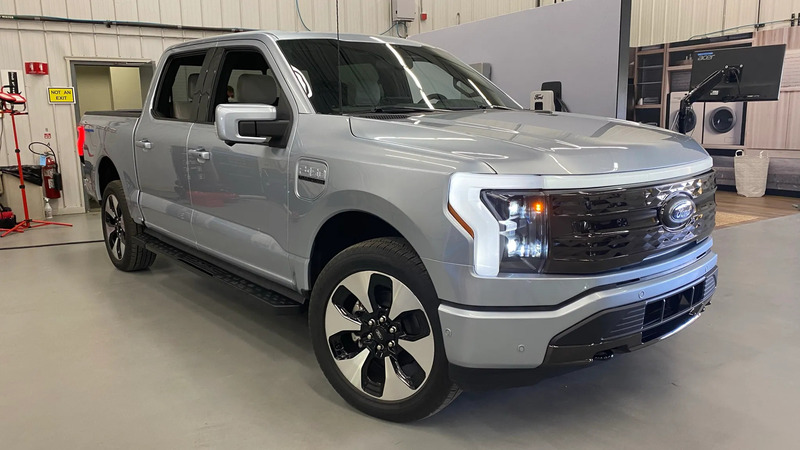
The good news is, unless you’re in a Ford Ranger or a Nissan XE (No knock against those trucks in the slightest), you can probably mount a truck camper on it. There’s a truck camper for everything from Tacomas to 1-ton monsters that can hold the largest truck campers.
Most of the conversation above covers the truck camper’s center of gravity, truck CoG, and weight. These are all absolutely necessary specs to know before you try purchasing a truck camper for your truck.
Regardless of what truck you own, you need to match the truck camper against your truck’s payload capacity.
It’s also important to realize that just because your truck is technically capable of carrying it, doesn’t mean it will fit your truck’s bed. There’s room for some truck campers to extend past the back, but only if the truck camper’s center of gravity is in the right spot or forward.
For those with small trucks, like the aforementioned Ranger, there are some awesome pop-up truck campers out there that are highly recommended as well. Check out the Northstar MC600, Four-Wheels Campers Project M Topper, or something from Bundutec USA. For EV trucks, Earth Cruiser is working on a nice slide-in RV camper as well.
4 FAQs About Truck Camper Center Of Gravity
1. Can a truck camper slide out of a truck?
Combining the correct truck camper center of gravity along with proper attachment to the truck ensures the camper is secure in the truck bed.
If these things are ignored, it could be possible for a camper to move around and potentially slide out of a truck bed. It is, however, rare for truck campers to slide out of a truck bed.
2. Can you change a truck camper’s center of gravity?
Manufacturers put a lot of thought and calculations into designing truck campers. The center of gravity is a key design point and critical to the proper use of the camper.
Altering the CoG of a truck camper definitely isn’t advisable and wouldn’t be easy to do anyway.
3. Where in the truck bed should a truck camper sit?
The truck camper’s center of gravity point should sit right above or forward of the axle, where the truck bed’s center of gravity is located.
4. How do I know if my truck camper’s center of gravity is off?
You will visibly note a rise in the frame of the truck in the forward half. As the camper’s weight is behind the truck’s pivot point, it will raise the front (like a seesaw). If you drive it, you’ll notice reduced traction, poor shocks, and reduced control of the vehicle.
Final Thoughts About Truck Camper Center Of Gravity
While all of the literature surrounding truck camper centers of gravity sounds complicated, it’s really easy to determine.
As long as you know the GVWR, curb weight, payload capacity, and the center of gravity on both the truck and the camper, you’re all set to choose a camper and make your measurements.
The good news is, aside from the measurements you need to make, your truck’s specs will provide you with all of the remaining information you need. Just bust out the manual from the glove compartment or check your truck model on the manufacturer’s website.
Armed with the truck camper’s center of gravity information, you can make the best decision when purchasing a new or used truck camper for your truck.
Related Reading:
– 8 Best Pop-Up Truck Campers With Bathrooms
– The Kimbo Camper: The Coolest Truck Camper You’ve Never Heard Of
– Scout Camper: The Modular Truck Camper
– 10 Best 3/4 Ton Truck Camper Brands
Thomas Godwin – Author and Part Time RVer
Thomas Godwin is a full-time freelance writer with a BFA in Creative Writing, a U.S. Marine, and an avid outdoorsman.
When he’s not writing, he’s raising chickens and Appleyard ducks. Thomas also constructs teardrop campers (attempting to anyway) and kayaks the Blackwater River with his wife, two daughters, and his Dobermans.

Source: https://rvblogger.com/blog/how-to-measure-a-truck-campers-center-of-gravity/

